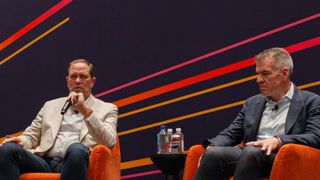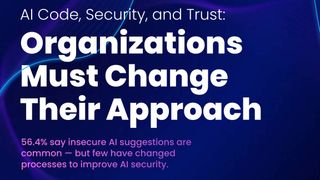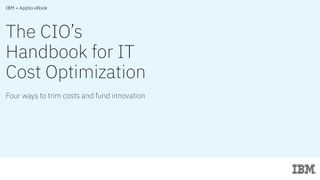"Our job is not to screw up”: Cisco CEO Chuck Robbins vows to make Splunk ‘better’ following acquisition
Former Splunk CEO Gary Steele has committed to keeping the firm's brand intact, even as the line between Cisco and Splunk services blurs

Chuck Robbins, CEO at Cisco, has told attendees that the firm has no plans to radically overhaul Splunk and is committed to maintaining high levels of investment so that Splunk can continue to innovate at the same pace.
In the opening keynote of Splunk .conf24, the company’s annual conference held this year in Las Vegas, Robbins outlined how Cisco sees its ownership of Splunk as a two-way deal in which both companies benefit.
“What we want this combination to do is to make everything you do every day and everything you've done with Splunk forever, just better,” said Robbins.
“Our job is not to screw up anything that you guys do really well today, but to bring you incremental capabilities.”
Cisco’s $28 billion acquisition of Splunk has been at the top of the agenda throughout Splunk conf.24, with both firms keen to emphasize the benefits of Splunk now being a Cisco company.
Robbins pointed to Cisco’s visibility of a billion endpoints and ability to monitor 400 billion security events every day as proof of the company’s valuable data and resilience platform it can bring to Splunk.
On the other hand, Cisco customers will benefit from Splunk’s observability and analytics experience. For example, Cisco AppDynamics users can now open logs in the Splunk platform while investigating performance problems as part of the same workflow.
Get the ITPro. daily newsletter
Receive our latest news, industry updates, featured resources and more. Sign up today to receive our FREE report on AI cyber crime & security - newly updated for 2024.
Maintaining the Splunk community
Throughout the first and second day’s keynotes, Cisco executives have repeatedly stated their commitment to treat Splunk and its community with respect and care.
“Great products get built by good companies, but movements get created by communities,” said Jeetu Patel, EVP and GM of security and collaboration at Cisco.
“One thing you should know about Cisco is we appreciate the passion with which, over the course of the past 20 years, this community has built this data movement.”
Gary Steele, president of Go-to-Market at Cisco and GM at Splunk, followed Robbins’ words onstage with a commitment to keeping Splunk’s identity intact post-acquisition.
At a press conference prior to the keynote, the pair rebuffed a comparison by IDC between Cisco’s acquisition of Splunk and Broadcom’s acquisition of VMware, which has sparked strong customer criticism. Steele emphasized that there has been “no change” in Splunk’s partner delivery, or the economics of delivering to customers.
“One of the most important things about the acquisition – and it’s hard for people to see this – is because the cultures are very similar, that teams feel very aligned,” said Steele.
“I think it’s made the environment that much more conducive to doing cool things,” he noted, adding that of Splunk's 8,000 employees he is the only person whose job title or reporting structure changed in the acquisition.
Stating that the acquisition is “not just a cost play,” Robbins noted that Cisco is investing more in Splunk rather than seeking to cut teams and bring existing products under its own banner.

See how businesses are executing their digital transformation initiative
“A lot of companies, when you do these acquisitions would be sitting in rooms figuring out ‘how do we cut, $250 million, $300 million, $400 million’,” he told the audience.
“We're not doing any of that, our model actually allocated more dollars to R&D to make sure that Splunk could continue down their innovation path, Cisco could convince continue down our innovation path, and we had money to actually fund the integration work so that we didn't have to take resources from the same road maps that existed before we brought the companies together.”
Splunk has emphasized the benefits of combining Splunk and Cisco products through integrations, such as Cisco XDR’s new connection with Splunk’s SIEM solution within Splunk Enterprise Security or the new integration of Cisco Talos within Splunk Attack Analyzer, Splunk Enterprise Security, and Splunk SOAR.
Robbins indicated that this is the primary benefit of the deal, with the first decision Cisco made on Splunk having been to reverse-integrate AppDynamics within Splunk products. This also applies to Splunk’s AI Assistant portfolio, with Splunk set to play a key role in Cisco’s AI approach.

Rory Bathgate is Features and Multimedia Editor at ITPro, overseeing all in-depth content and case studies. He can also be found co-hosting the ITPro Podcast with Jane McCallion, swapping a keyboard for a microphone to discuss the latest learnings with thought leaders from across the tech sector.
In his free time, Rory enjoys photography, video editing, and good science fiction. After graduating from the University of Kent with a BA in English and American Literature, Rory undertook an MA in Eighteenth-Century Studies at King’s College London. He joined ITPro in 2022 as a graduate, following four years in student journalism. You can contact Rory at rory.bathgate@futurenet.com or on LinkedIn.



